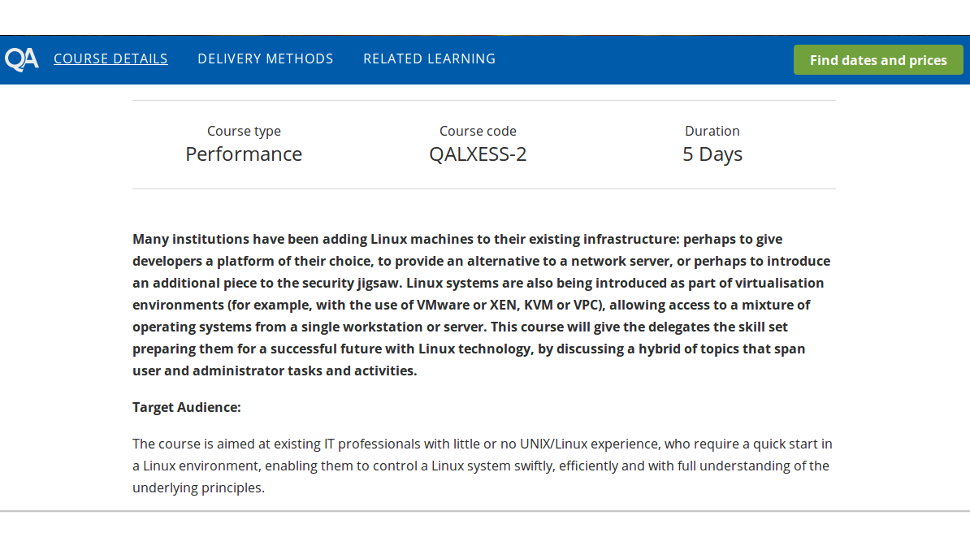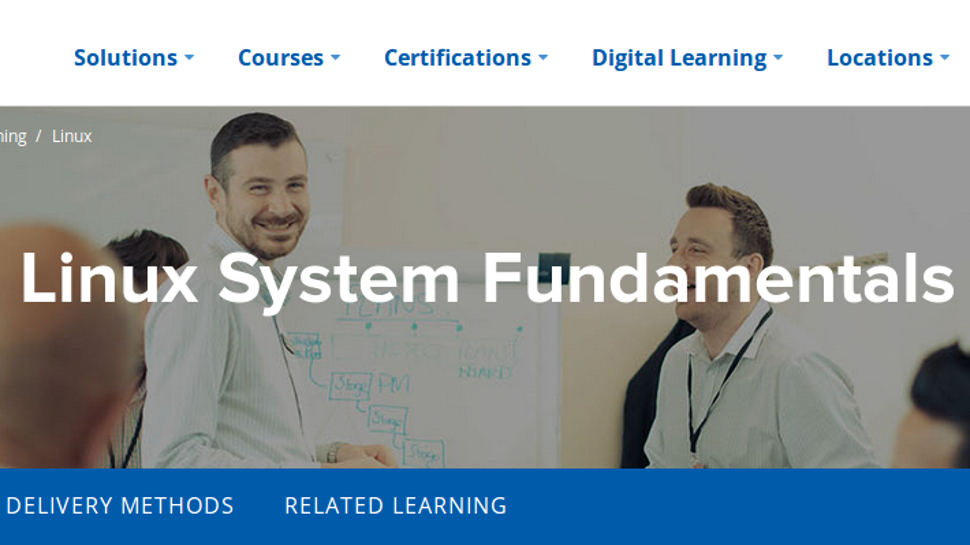TechRadar Verdict
Linux System Fundamentals does what it says on the tin via an interactive classroom, but this course seems expensive nonetheless.
Pros
- +
Course can be taken in a real classroom or remotely
- +
Truly cross-platform – heavy emphasis on command line
- +
Great advice on running basic commands and scripts
Cons
- -
Course fee is quite high
- -
Website doesn’t list instructors’ qualifications
- -
Virtualisation isn’t discussed in depth
Why you can trust TechRadar
QA has been around for 30 years and offers a tremendous amount of courses for professionals to gain certification and new skills. The company has also won numerous awards, and is an official partner of Microsoft, Cisco and VMware.
Its website includes eight Linux courses, including this one – Linux System Fundamentals – which is aimed at IT professionals with little or no experience of the OS, as something of a ‘quick start’ guide.
All training is guided by an instructor at one of the QA training centres around the UK or as an ‘attend from anywhere’ course which you can do remotely. After contacting QA for clarification, we found the course fee is the same, regardless of which method you choose – currently £3,087 ($3,980). It takes place over five days.
Linux System Fundamentals lives up to its name in that it focuses strongly on helping you master the Linux command line. The desktop environment and graphical editors are discussed towards the end of the course, however, so these aren’t topics which are left completely untouched.
The course itself is divided into 17 sections. The first, which is entitled 'Just for Fun', explains some of the advantages of using Linux, as well as a little about the history of the OS. This section also covers some basic principles of OSS (open source software) and the GPL Licence, which may be unfamiliar to IT workers who've previously used proprietary Windows or macOS programs. This is especially important for developers, as they may wish to create applications for use within a corporate environment.
The next section details how to access a Linux system, as well as explaining the difference between ordinary and super users. This is contrast to other courses we've reviewed which discuss user groups much later in the course. Since one of the first tasks when setting up a system is creating a user account, this topic is well placed.
The section continues by detailing the command line structure and providing a few examples of common commands, in addition to listing file reading utilities. The section also touches on using files with absolute and relative pathnames, in a bid to help you become comfortable with navigating the system.
Sign up to the TechRadar Pro newsletter to get all the top news, opinion, features and guidance your business needs to succeed!
This is expanded on in the next section (‘Using Files and Directories’) by exploring the layout of a Linux system both from a user's perspective and the system's. File permissions are not covered in any great depth but trainees are made aware of how Linux treats different users. This section also touches on how to copy, move and remove files and folders.

Linux System Fundamentals also devotes a section to editing text with Vim. This includes how to place Vim into command or insert mode, and details some useful commands as well as how to search for (and substitute) text. The equally popular 'nano' text editor is not covered but this section also looks at some common GUI text editors too, although having mastered Vim, there's unlikely to be much need for these.
The course also devotes several sections to the Bash environment. These discuss creating shell variables and startup files, as well as variable and command substitution. That’s followed by a section which is dedicated to the root account. This expands on the brief explanation provided previously and details the specifics of how to start an 'su' interactive session as well as using 'sudo' to run one-off commands as root.
There's also a dedicated section on working in a network environment. It takes an even-handed approach to setup, detailing Terminal commands such as ifconfig, ping and netstat, as well as discussing some GUI configuration programs.
The following section is dedicated to the X Window environment, which is in rather stark contrast to the previous topics which all focused on the command line where possible. It includes a detailed rundown of window managers and desktop environments such as Gnome and KDE, while avoiding recommending one over another.
The final part of the course returns to the command line, explaining how to write simple shell scripts, including looping commands, setting parameters and even accepting inputs.
Final verdict
QA’s Linux training brochure touts Linux System Fundamentals as a way to master basic programming concepts, and it certainly delivers in this respect, as well as providing some background information on administering Linux systems.
The clear emphasis on the Linux command line means that the course is truly cross-platform – even when graphical applications are mentioned, they are available for most Linux distros, and when the X Window manager is discussed, trainees aren't told which desktop environment to choose.
However, you need to bear in mind that the course explores the fundamentals of the Linux system, and is not intended for people who are simply interested in a quick introduction. QA, however, does offer a one-day Linux 'primer' course if that's all you need.
As previously discussed, sessions take place in a classroom with a real instructor, although you can choose to log in remotely if you wish. It's a pity that no discount is offered for opting to take the course remotely, as this would most likely save both trainees and QA in terms of costs.
The high course fee reflects the expense of paying a professional to guide students, as opposed to watching a series of training videos. As all training is live, there's also no option for a subscription or trial period. Unlike other training providers we've reviewed, QA doesn't detail its instructors’ qualifications on the website, although given the company’s excellent reputation for training, this is pretty much a moot point.
Ultimately, whether or not this course represents value-for-money depends on your learning style. The Linux Foundation offers relatively inexpensive online courses in system administration which cover most of the topics focused on by Linux System Fundamentals, and you can do these in your own time, rather than over five days.
That said, you won't receive the same level of support if you run into difficulties. Take some time to look at the other Linux course reviews on our site – including the Linux Foundation’s offering – and decide what's right for you.
- 10 best Linux distros for privacy fiends and security buffs in 2017
- 7 best Linux distros: which one is right for you?
- 5 of the most popular Linux gaming distros
- 10 of the most popular lightweight Linux distros
Nate Drake is a tech journalist specializing in cybersecurity and retro tech. He broke out from his cubicle at Apple 6 years ago and now spends his days sipping Earl Grey tea & writing elegant copy.
